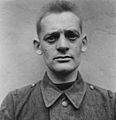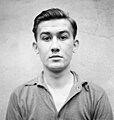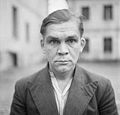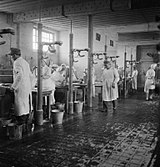User:Jan D. Berends/Bergen-Belsen cleanup
| This is not a Wikipedia article: It is an individual user's rough notes page, and may be incomplete and/or unreliable. |
| Bergen-Belsen | |
|---|---|
| Concentration camp | |
 Entrance Bergen-Belsen | |
| Coordinates | 52°45′28″N 9°54′28″E / 52.75778°N 9.90778°E |
| Location | Bergen, North-Western Germany |
| Operated by | Wehrmacht, Schutzstaffel (SS) |
| Original use | Workers dwellings |
| Operational | September 1939 – 15 April 1945 |
| Number of gas chambers | none |
| Inmates | Jews, Roma and Sinti (Gypsies), homosexuals, Soviet POWs |
| Number of inmates | 120,000 (concentration camp); over 22,000 (POW's camp)[1] |
| Killed | 52,000 (concentration camp); over 20,000 (POW's camp) |
| Liberated by | 11th Armoured Division (United Kingdom) |
| Notable inmates | Josef Čapek, Anne Frank, Margot Frank, Abel Herzberg Josef Weiss, Judenältester |
| Notable books | Poems from Concentration Camp, The Diary of a Young Girl |
| Website | Gedenkstätte Bergen-Belsen |
Bergen-Belsen ⓘ was a Nazi concentration camp near Belsen and Bergen in the Celle district, in the Province of Hanover (now Lower Saxony), Germany. Originally established as a prisoner of war camp, it became in 1943 a internment camp on the orders of Heinrich Himmler, where Jewish hostages were held with the intention of exchanging them for German prisoners of war held overseas.[2] Later still the name was applied to the Bergen-Belsen displaced persons camp established nearby, but it is most commonly associated with the concentration camp it became as conditions deteriorated between 1943 and 1945. During this time an estimated 20,000 Russian and Polish prisoners of war and a further 50,000 inmates died there,[1][3]up to 35,000 of them dying of typhus in the first few months of 1945.[4] The camp was liberated on April 15, 1945, by the British, 60,000 prisoners were found inside, most of them seriously ill,[4] and another 13,000 corpses lay around the camp unburied.[5]
Army ConstructionCamp[edit]

The first plans for establishing a military training area on the Lüneburg Heath were laid in 1934 as part of the military re-armament of the German Reich as Nazi Germany was in the 1930s preparing for war.
On 16 March 1935, under the government of Adolf Hitler, Germany violated the Treaty of Versailles by introducing compulsory military conscription in Germany and rebuilding the armed forces. This included a new Navy (Kriegsmarine), an Air Force (Luftwaffe), and the first full armoured divisions (Panzerwaffe).[6] Due to the sparse population and the varied landscape, which covered over 280 square kilometres of land, the Bergen area (Heidmark) was selected for creating the largest exercise area for the German Panzer force, in spite of opposition from the local population. Within a few years 3,635 inhabitants in 25 villages had to leave their homes.[7]
Huge barracks, planned to house 15,000 men each, were built on the area. To put up the 3000 German and Polish labourers a Heeresneubauarbeiterlager (Construction Workers Camp) was established. The camp comprised of 30 + 18 large huts in the woods near the hamlet of Belsen, south of the small town of Bergen. The camp is referred to as the 'Waldlager' (Forest Camp).[8]
After the military camp was completed, most sheds were left empty, used for storage or destroyed.[4]
Nowadays the area is in use by the Nato, it is called the Bergen-Hohne Training Area.
POW Camp[edit]

In September 1939 a prisoner of war camp was established at Fallingbostel, and the nearby Bergen-Belsen site became a Häftlingslager, or "prison camp", initially housing around 500 prisoners who were used as construction workers for the Fallingbostel project.[9][10] In June 1940 it became a prisoner of war camp for around 600 French and Belgian soldiers, under the authority of the Wehrmacht, and in May 1941 it was designated prisoner of war camp Stalag XI-C, (Stalag XI-C/311 for the Belgian and French POW's). Conditions in the camp were very basic, with inadequate food and little shelter. Around 20,000 Soviet prisoners of war were sent to the camp between July 1941 and the spring of 1942, of whom about 18,000 died of hunger, cold and disease. In June 1943 Stalag XI-C/311 was disbanded and the hospital for POW's in Bergen-Belsen became a branch camp of Stalag XI B at Fallingbostel.[11]
After Fascist Italy surrendered on 29 September 1943 to the United Nations,[12] the Wehrmacht occupied northern Italy. Around 600,000 soldiers whom refused to fight for the Germans were disarmed and deported to Germany for forced labour. These soldiers were viewed as traitors. They were denied the POW status instead classified as Italian military internees (IMI).
The Oerbke and Wietzendorf camps were used as transit camps for tens of thousands of Italian military internees. Wietzendorf was the site of one of the largest camps for Italian officers known as Oflag 83. The patients of the Oerbke POW camp hospital were transferred to a separate section of the Bergen-Belsen POW hospital in late July 1944. Most of these Italian prisoners were suffering from tuberculosis or had been injured while working. 142 Italian military internees died in the Bergen-Belsen hospital by the end of the war and were buried in a separate area at the edge of the POW cemetery.[13]
Residence Camp[edit]
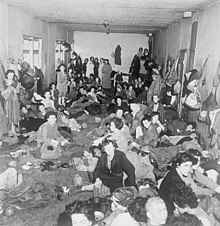
After the Niederhagen concentration camp was closed on 30 April 1943, the Waffen-SS Sturmbannführer Adolf Haas, and 90 SS men under his command, escorted on 7 May 1943 a prisoner transport to Bergen-Belsen. Haas was appointed Lagerkommandant (camp commander) of the Aufenthaltslager (Residence Camp), designed to hold prominent non-German Jews, who could be exchanged for German citizens interned abroad.[14][15] The camp came under supervision of the SS-Wirtschafts-Verwaltungshauptamt (SS Economic and Administrative Department), Office Group D, which administered the concentration camp system.[4] The camp was initially been designated Zivilinterniertenlager Bergen-Belsen (civilian internment camp Bergen-Belsen), in June 1943 it was re-designated Aufenthaltslager, to avoid inspection since the Geneva Conventions stipulated that the former type of facility must be open to inspection by international committees.[9]
The Camp should be primarily reserved for Austauschjude (Exchange Jews), Jews who were candidates for prisoner swaps against German civilians, whom were interned in enemy countries.
In the Second World War, the belligerent countries exchanged several times some of them civilian internees detained against their own citizens who were interned in the respective enemy state. Remarkably, however, in this case was that the Nazis at times in which Jews in the extermination camps were murdered en masse, in the Residence Camp Bergen-Belsen, certain Jews for a replacement ready presented.
At least 14,600 Jewish prisoners were transported, between July 1943 and December 1944, to the Residence Camp. In total only ca. 2,560 prisoners were released from Bergen-Belsen and travelled abroad.
Layout of the Residence Camp[edit]
A construction commando of 600 inmates was housed in a separated part of the Residence Camp. The Residence Camp was divided by barbed wire in sections. The several detained groups were isolated from each other and were treated differently.[16]
Star Camp[edit]
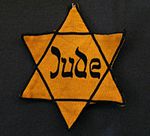

Star Camp (Sternlager) or Vorzugslager (Privileged Camp), so called because the prisoners had to wear the yellow Star of David but not vertically striped prison uniforms.
Star Camp inmates were made to work, many of them in the shoe commando which salvaged usable pieces of leather from shoes collected and brought to the camp from all over Germany and Occupied Europe.[17] Families were permitted to meet during the day,[10] and in general the Star Camp prisoners were treated less harshly than some other classes of Bergen-Belsen prisoners, due to their perceived potential exchange value, until fairly late in the war when they suffered severely from malnutrition.
In July 1944 around 4,100 Exchange Jews were detained,[18] thereunder Jews from Saloniki, seven transports Dutch Jews from Westerbork concentration camp in The Netherlands, North-African Jews, small groups of French, Yugoslavian and Albanian Jews.
Only a small part of these Exchange Jews were freed. In April 1944 only 222 persons departed the camp in a Palestine-exchange.
136 persons, with South American passports, travelled in January 1945 to Switzerland; others were hold up in the internment camp of Biberach.
On 28 October 1944 Anne and Margot Frank were chosen in a selection to be transferred from Auschwitz to Bergen-Belsen. Their mother Edith Frank was left behind where it was reported she died of starvation. Anne and Margot would both die in March 1945 in the typhus epidemic only a few weeks before the camp's liberation on 15 April 1945.[19]
Special Camp[edit]
The Special Camp (Sonderlager) contained two transports, in mid June 1943 of 2400 Jews whom, although of Polish origin from Warsaw, Lemberg and Kracow, were citizens of neutral countries in Latin America and hold Palestine emigration papers. Regardless of their papers these people were deported in the winter 1943/44 to the gas chambers of Auschwitz[18]
Neutrals' Camp[edit]
The Neutrals' Camp (Neutralenlager) barracked, from July 1944 to early March, for 250 up to 360 Jews from neutral countries, holding papers from Argentina, Portugal, Spain and Turkey. De living conditions were far more better than in the Star Camp. On 4 March 105 Jews were released for Turkey.[18]
Hungarians' Camp[edit]
In the Hungarians' Camp (Ungarnlager) lived since 8 July 1944 a total of 1.684 Hungarian Jews housed.[18] They were deported from Hungary on the so-called Kastner train. The train was named after Rudolf Kastner, who negotiated with the SS officer Adolf Eichmann to allow the Jews to escape in exchange for money, gold, diamonds and coffee beans. This group eventually arrived on 25 January 1945 in Switzerland.[20] [21][22][23]
Prisoners' Camp[edit]
The Prisoners' Camp (Häftlingslager) contained prisoners previously held at Buchenwald and Natzweiler who were used for the construction of the Internierungslager (Internment camp)
Concentration Camp[edit]

In March 1944, part of the camp was re-designated as an Erholungslager ("recovery camp"),[24] where prisoners too sick to work were brought from other camps. In August 1944, a shipment of approximately 8,000 female prisoners of various nationalities arrived from Auschwitz, most of whom were sent to Arbeitskommandos to work in factories, and from October 1944 captured Armia Krajowa (Polish Home Army) soldiers also began arriving at the camp.[9] In all there were eight separate sections to the camp with different groups, treated differently according to their status.[25]
On 2 December 1944 saw the completion of the change-over of Bergen-Belsen into a concentration camp when SS-Hauptsturmführer Josef Kramer, previously at Auschwitz-Birkenau, became the new camp commander. The number of inmates in the camp on 2 December 1944 was 15,257.[26] In 1945 large numbers of prisoners were moved to Belsen from the eastern camps as the Soviet forces advanced. The resulting overcrowding led to a vast increase in deaths from disease (particularly typhus) and malnutrition in a camp originally designed to hold about 10,000 inmates. The number of inmates increased from 22,000 on 1 February 1945, to 41,520 on 1 March, 43,042 on April 1 and ultimately to about 60,000 on April 15. The number of deaths increased from 7,000 in February to 18,168 during March and 9,000 during the first half of April. The bodies of these prisoners were buried in mass graves.
There were no gas chambers in Bergen-Belsen, since the mass executions took place in the camps further east. Nevertheless, an estimated 50,000 Jews, Czechs, Poles, anti-Nazi Christians, homosexuals, and Roma and Sinti (Gypsies) died in the camp from genocide by neglect.[27] Among them were Czech painter and writer Josef Čapek (est. April 1945).
After the war, there were allegations that the camp (or possibly a section of it), was "of a privileged nature", compared to others. A lawsuit filed by the Jewish community in Thessaloniki against 55 alleged collaborators claims that 53 of them were sent to Bergen-Belsen "as a special favor" granted by the Germans.[28]
Sub-camps[edit]
Bergen-Belsen had three sub-camps (German: Aussenlager):
- Aussenlager Benefeld housed between September and October 1944 around 600 Polish Jewesses whom worked as slave labourers at the explosive factory of Eibia GmbH, which was partly underground.
- Aussenlager Hambühren (AKA Hambühren-Ovelgönne or Waldeslust), here worked from August 1944 until 4 February 1945 about 400 Jewesses mining of a salt dome and at the construction of railway tracks and barracks.
- Aussenlager Unterlüß (AKA Tannenberg) accommodated from end of August 1944 until 13 April 1945 up to 900 Women, whom for a part worked in a munition factory and for the greater part at road and railway track construction.[29]
Liberation[edit]


When the British and Canadians advanced on Bergen-Belsen in 1945, the German army negotiated a truce and exclusion zone around the camp to prevent the spread of typhus. Under the agreement, Hungarian and regular German troops of the Wehrmacht guarding the camp returned to German lines when Allied troops liberated the camp on April 15, 1945.[30] Although many SS guards had fled the camp, a small number remained, wearing white armbands as a sign of surrender. The retreating Germans sabotaged the water supply to the barracks,[2] making it difficult for the Allied troops to treat the ill prisoners.
When British and Canadian troops finally entered the camp they found thousands of bodies unburied and approximately 55,000 inmates,[9] most acutely sick and starving. Evacuation of the camp started on 21 April 1945. The surviving prisoners were thoroughly deloused with DDT, sprayed with pressure air hoses, and moved to a nearby German Panzer army camp,[31] which became the Bergen-Belsen DP camp. On 19 May 1945 the evacuation was completed and the last barracks were burned down.[24]
The liberators whom worked in the camp were also daily sprayed with DDT (typhus is spread by lice). The medics vaccinated them against various other diseases. Fortunately, few if any soldiers contracted typhus or any other disease than dysentery, but they kept on working.[31]
The Bergen-Belsen DP camp became the largest DP camp in Germany, for the Sh'erit ha-Pletah (the surviving remnant) of the Jewish survivors, with 11,000 residents in 1946 and the only exclusively Jewish facility in the British zone.
The remaining SS personnel were then forced by armed Allied troops to bury the bodies in pits.[27]
The scenes that greeted British troops were described by the BBC's Richard Dimbleby, who accompanied them:
Here over an acre of ground lay dead and dying people. You could not see which was which... The living lay with their heads against the corpses and around them moved the awful, ghostly procession of emaciated, aimless people, with nothing to do and with no hope of life, unable to move out of your way, unable to look at the terrible sights around them ... Babies had been born here, tiny wizened things that could not live ... A mother, driven mad, screamed at a British sentry to give her milk for her child, and thrust the tiny mite into his arms, then ran off, crying terribly. He opened the bundle and found the baby had been dead for days.
"This day at Belsen was the most horrible of my life".[32]
For public opinion in Western countries in the immediate post-1945 period, the name "Belsen" became emblematic of Nazi horrors in general. The even greater horrors of Auschwitz, a camp which was liberated by the Soviets and of which Western soldiers and journalists had no direct experience, became widely known only later.
Bergen-Belsen concentration camp was then burned to the ground by flamethrowing "Bren gun" carriers and Churchill Crocodile tanks because of the typhus epidemic and louse infestation.[33] In spite of massive efforts to help the survivors, about another 9,000 died in April, and by the end of June 1945 another 4,000 had died (after liberation a total of 13,994 people died). On the 13th day after liberation, the Luftwaffe bombed one of the hospitals in the DP camp, injuring and killing several patients and Red Cross workers. The total number of deaths at Bergen-Belsen from 1943 to June 1945 was about 50,000.[9]
The British troops and medical staff tried these diets to feed the prisoners, in this order:[34]
- Bully beef from Army rations. Most of the prisoners' digestive systems were in too weak a state from long-term starvation to handle such food.
- Skimmed milk. The result was a bit better, but still far from acceptable.
- Bengal Famine Mixture. This is a rice-and-sugar-based mixture which had achieved good results after the Bengal famine of 1943, but it proved less suitable to Europeans than to Bengalis because of the differences in the food to which they were accustomed. Adding the common ingredient paprika to the mixture made it more palatable to these Europeans and recovery started.
List of personnel[edit]
- SS-Sturmbannführer Adolf Haas, camp commander till 2 December 1944, 1 May 1945 missed in action.
- SS-Hauptsturmführer Josef Kramer, camp commander 2 December 1944 – 15 April 1945, Nickname: The Beast of Belsen, a notorious war criminal, directly responsible for the deaths of thousands of people, hanged.
- SS-Hauptsturmführer Siegfried Seidl, chief of the Sicherheitspolizei (Security Police), 1943 – March 1944, convicted to death by the Volksgericht (Austrian People's Court), hanged.[35]
- Fritz Klein, camp physician hanged.
- SS-Obersturmführer Franz Hössler, substitute camp commander till 15 April 1945, hanged.
- SS-Hauptscharführer Peter Weingartner, hanged.
- SS-Hauptscharführer Franz Xaver Trenkle, Schutzhaftlagerführer spring 1944 till January 1945, convicted in the Dachau process, hanged.
- Supervisor SS-Oberaufseherin Elisabeth Volkenrath, hanged.
- SS-Hauptscharführer Franz Stofel AKA Xaver Stärfel or Trenkle, leaded in April 1945 the death march from Kleinbodungen to Bergen-Belsen, hanged.
- SS-Hauptscharführer Wilhelm Dörr, hanged.
- SS-Aufseherin Juana Bormann, hanged.
- SS-Rottenführer Karl Francioh, hanged.
- SS-Aufseherin Irma Grese,March en April 1945, hanged.
- Funktionshäftling Erich Zoddel, life sentence, later death penalty for an after truce murder, hanged.[36]
- SS-Aufseherin Hertha Ehlert, 15 years in prison.
- SS-Aufseherin Herta Bothe, AKA the Sadist of Stutthof concentration camp, 10 years in prison.
Aftermath[edit]

The Belsen Trial[edit]
Officially called the "Trial of Josef Kramer and 44 others", the trial started on September 17 1945 in the town gymnasium at 30 Lindenstrasse, Lüneburg, which was converted to a Court of Justice for the purpose of holding the trials, ten days before the trials started against 45 former SS men, women and kapos (prisoner functionaries) from the Bergen-Belsen and Auschwitz concentration camps.
The trial took place before a British military court and lasted until 17 November 1945.[37] Of the 77 arrested former SS staff 17 died before 1 June due to the typhus epidemic.[38]
Many of the SS men and women served before at the Arbeitslager (labour) camp Mittelbau Dora and the Ravensbrück, Auschwitz I, II, III, and Neuengamme concentration camps.
Eleven defendants were sentenced to death by hanging. Erich Zoddel was sentenced to lifetime imprisonment.Five defendants were sentenced to 15 years imprisonment; nine accused were sentenced to 10 years imprisonment; two got five years; one two years and another one a year imprisonment; the tribunal acquitted fourteen defendants.
Gallery of Convicted War Criminals[edit]
At the trial, the world got its first view of
-
Defendant Number 1 Josef Kramer
-
Defendant Number 2
Fritz Klein -
Defendant Number 3
Peter Weingartner -
Defendant Number 5 Franz Hössler
-
Defendant Number 6 Juana Bormann
-
Defendant Number 7 Elisabeth Volkenrath
-
Defendant Number 8 Hertha Ehlert
-
Defendant Number 9
Irma Grese -
Defendant Number 22 Ansgar Pichen
-
Defendant Number 25 Franz Stofel, AKA Xaver Stärfel
-
Defendant Number 27 Wilhelm Dörr
-
Defendant Number 29 Erich Zoddel
Documentation Centre[edit]

Bergen-Belsen fell into neglect after the burning of the buildings and the closure of the nearby displaced persons' camp. The area reverted to heath, with few traces of the camp remaining. Ronald Reagan's visit to West Germany in 1985 (see Bitburg) included a hastily arranged stop at Bergen-Belsen, which prompted the West Germans to put together a small documentation center. It soon became inadequate to the accumulating archives, to the general liberalizing process of German identity building after the Berlin Wall fell, and for the growing public appetite abroad for Holocaust museums, along with the tourist economy they generated.[39]On April 15, 2005, there was a commemorative ceremony, and many ex-prisoners and ex-liberating troops attended.[40][41]
In October 2007 the redesigned memorial site was opened, including a large new Documentation Centre and permanent exhibition on the edge of the newly redefined camp, whose structure and layout can now be traced. The site is open to the public and includes a monument to the dead, some individual memorial stones and a "House of Silence" for reflection.
Personal accounts[edit]

- Michael Bentine wrote this on his encounter with Belsen:
- We were headed for an airstrip outside Celle, a small town, just of Hanover. We had barely cranked to a halt and started to set up the ‘ops’ tent, when the Typhoons thundered into the circuit and broke formation for their approach. As they landed on the hastily repaired strip – a ‘Jock’ [Scottish] doctor raced up to us in his jeep.
- ‘Got any medical orderlies?’ he shouted above the roar of the aircraft engines. ‘Any K rations or vitaminised chocolate?’
- ‘What’s up?’ I asked for I could see his face was grey with shock.
- ‘Concentration camp up the road,’ he said shakily, lighting a cigarette. ‘It’s dreadful – just dreadful.’ He threw the cigarette away untouched. ‘I’ve never seen anything so awful in my life. You just won’t believe it 'til you see it – for God’s sake come and help them!’
- ‘What’s it called?’ I asked, reaching for the operations map to mark the concentration camp safely out of the danger area near the bomb line.
- ‘Belsen,’ he said, simply.
- Millions of words have been written about these horror camps, many of them by inmates of those unbelievable places. I’ve tried, without success, to describe it from my own point of view, but the words won’t come. To me Belsen was the ultimate blasphemy.
- After VE. Day I flew up to Denmark with Kelly, a West Indian pilot who was a close friend. As we climbed over Belsen, we saw the flame-throwing Bren carriers trundling through the camp – burning it to the ground. Our light Bf 108 rocked in the superheated air, as we sped above the curling smoke, and Kelly had the last words on it.
- ‘Thank Christ for that,’ he said, fervently.
- And his words sounded like a benediction.[citation needed]
- Major Leonard Berney, Staff Officer (Anti-Aircraft Artillery), attached to the HQ of 8th Corps of the British 2nd Army.
- I remember being completely shattered. The dead bodies lying beside the road, the starving emaciated prisoners still mostly :behind barbed wire, the open mass graves containing hundreds of corpses, the stench, the sheer horror of the place, were :indescribable. None of us who entered the camp had any warning of what we were about to see or had ever experienced anything :remotely like it before.[31]
Picture gallery[edit]
-
17, 18 April 1945, Former guards are made to load the bodies of dead prisoners onto a truck for burial. -
Fritz Klein stands amongst corpses in Mass Grave 3.
-
Polish wooden cross, the oldest monument in Bergen-Belsen.
-
1–4 May 1945, German doctors and nurses wash and delouse the sick.
-
17 April 1945, Bergen-Belsen inmates, whom carried dead bodies from the huts in the open air for the funeral.
Media[edit]
- The Relief of Belsen (2007 film)
- Memorandum (1965 film)
- Film footage of Belsen concentration camp and its destruction
Literature[edit]
- Leslie Hardman, British Army Jewish Chaplain and Rabbi, was the first Jewish Chaplain to enter the camp, two days after its liberation, and published his account in the collective book "Belsen in history and memory" [2].
- Memories of Anne Frank, a book by Hannah Goslar
- In his book From Belsen to Buckingham Palace Paul Oppenheimer tells of the events leading up to the internment of his whole family at the camp and their incarceration there between February 1944 and April 1945, when he was aged 14 – 15.[3] Following publication of the book, Oppenheimer personally talked to many groups and schools about the events he witnessed. This work is now continued by his brother Rudi, who shared the experiences.
- Anita Lasker-Wallfisch describes life in Belsen, its liberation and her period in the displaced persons camp in her autobiography Inherit the Truth [3]
References[edit]
- ^ a b "Prisoner of war and concentration camp Bergen-Belsen: POW-camp". Bergen-Belsen Memorial website. Retrieved 2011-12-13.
- ^ a b Shephard, Ben (2006), "After Daybreak - The Liberation of Belsen, 1945", London, Random House. ISBN 9781844135400
- ^ a b Oppenheimer, Paul (1996), "From Belsen to Buckingham Palace", Nottingham, Quill Press. ISBN 0-9536-2803-5
- ^ a b c d "Bergen-Belsen", United States Holocaust Memorial Museum.
- ^ "The 11th Armoured Division (Great Britain)"
- ^ A. Hitler (3 February 1933). "Hitler spricht vor den Befehlshabern des Heeres und der Marine". NS-Archiv Dokumente zum Nationalsozialismus. Retrieved 16 December 2011.(in German)
- ^ Firehead (2 December 2009). "Ehemalige Ortschaften auf dem Truppenübungsplatz Bergen-Belsen". Retrieved 17 December 2011.(in German)
- ^ "BergenBelsen.co.uk". Stalag XIC (311) and KZ Bergen-Belsen, A History From 1935. Retrieved 19 December 2011.
- ^ a b c d e Godeke, Monika (ed) (2007). Bergen-Belsen Memorial 2007: Guide to the Exhibition. Scherrer. ISBN 978-3-9811617-3-1.
{{cite book}}:|first=has generic name (help) - ^ a b "KZ Bergen-Belsen in 1944". Bergen-Belsen Memorial website. Retrieved 19 December 2011.
- ^ "Prisoner of war and concentration camp Bergen-Belsen: Chronicle". Bergen-Belsen Memorial website. Retrieved 2011-12-13.
- ^ PIETRO BADOGLIO, DWIGHT D. EISENHOWER (29 September 1943). "Armistice with Italy Instrument of Surrender". The Avalon Project. Department of State Government Printing Office, Washington, DC. Retrieved 19 December 2011.
- ^ "Italian military internees". Bergen-Belsen Memorial website. Retrieved 19 December 2011.
- ^ Kirsten John-Stucke. "22. September 1934 - Übernahme der Wewelsburg durch Heinrich Himmler". Internet-Portal 'Westfälische Geschichte. Retrieved 14 December 2011.(in German)
- ^ "Bergen - Belsen Timeline 1943". Stalag XIC (311) and KZ Bergen-Belsen, A History From 1935. Retrieved 14 December 2011.
- ^ Zahlenangaben in diesem Abschnitt nach Eberhard Kolb: Bergen-Belsen 1943–1945….
- ^ Oestreicher, Felix Hermann (2000). Ein jüdischer Arzt-Kalender-Durch Westerbork und Bergen-Belsen nach Tröbitz. Konzentrationslager-Tagebuch 1943-1945. ISBN [[Special:BookSources/ISBN 3-89649-411-2|'"`UNIQ--templatestyles-00000085-QINU`"'[[ISBN (identifier)|ISBN]] [[Special:BookSources/3-89649-411-2 |3-89649-411-2]]]].
{{cite book}}: Check|isbn=value: invalid character (help); Unknown parameter|coauthors=ignored (|author=suggested) (help); templatestyles stripmarker in|isbn=at position 1 (help) - ^ a b c d "Bergen-Belsen" (PDF). Shoah Resource Center. Yad Vashem. Retrieved 19 December 2011.
- ^ Müller, Melissa. Anne Frank: The Biography Macmillan, 1998. ISBN 0-8050-5996-2 pp. 119–120
- ^ Alexandra-Eileen Wenck: Zwischen Menschenhandel und Endlösung… Paderborn 2000, ISBN 3-506-77511-1, S. 335.(in German)
- ^ Braham, Randolph (2004): Rescue Operations in Hungary: Myths and Realities, East European Quarterly 38(2): 173-203.
- ^ Bilsky, Leora (2004): Transformative Justice : Israeli Identity on Trial (Law, Meaning, and Violence), University of Michigan Press.
- ^ Bauer, Yehuda (1994): Jews for Sale?, Yale University Press.
- ^ a b Bergen-Belsen, Jewish Virtual Library
- ^ 8 separate sections
- ^ Haas & Kramer. "The Bergen-Belsen Handover Document between Sturmbannführer Adolf Haas and Hauptsturmführer Josef Kramer". Stalag XIC (311) and KZ Bergen-Belsen, A History From 1935. Retrieved 17 December 2011.(in German)
- ^ a b "The Liberation". Bergen-Belsen Memorial website. Retrieved 21 December 2011.
- ^ Salonika Jews Sponsor Trial Of Collaborators
- ^ Thomas Rahe: Aussenlager von Bergen-Belsen. In: Wolfgang Benz, Barbara Distel: Der Ort des Terrors. Band 7, München 2008, p. 219 f.
- ^ Harries, Schmidt, Grosan & Taylor Balfour. "Truce - Agreement Reference Number: 649". Stalag XIC (311) and KZ Bergen-Belsen, A History From 1935. Retrieved 14 December 2011.
{{cite web}}: CS1 maint: multiple names: authors list (link) - ^ a b c Leonard Berney (8 June 2004). "The Liberation of Belsen Concentration Camp". An archive of World War Two memories. BBC. Retrieved 23 December 2011.
- ^ Richard Dimbleby, "Liberation of Belsen", BBC News, April 15, 1945.
- ^ Fletcher, David (2007), "Churchill Crocodile Flamethrower", Volume 136 of New Vanguard, Osprey Publishing, pp. 33 & 47, ISBN 978-1846030833
- ^ television program The Relief Of Belsen, Channel 4 (UK commercial television), 9.00-11.05 pm on Monday 15 October 2007.
- ^ G. Anderl: "Seidl Siegfried". In: Österreichisches Biographisches Lexikon 1815–1950 (ÖBL). Vol. 12, Austrian Academy of Sciences, Vienna 2005, ISBN 3-7001-3580-7, p. 126 f. (Direct links to "p. 126", "p. 127")(in German)
- ^ "First Belsen Trial Kapo Erich Zoddel". Stalag XIC (311) and KZ Bergen-Belsen, A History From 1935. Retrieved 17 December 2011.
- ^ "Foreword to The Belsen Trial of Joseph Kramer and 44 Others" Official website of the University of the West of England, Bristol. (January 29, 2007) Summary of Law-Reports of Trials of War Criminals, the United Nations War Crimes Commission, Volume II, London, HMSO, 1947. Retrieved May 10, 2010
- ^ Claudia Taake: Angeklagt: SS-Frauen vor Gericht. P. 112 f.
- ^ "The Holocaust, Viewed Not From Then but From the Here and Now", The New York Times, viewed 22 January 2009 [1]
- ^ Liberation of Belsen commemorated. BBC News, 15 April 2005
- ^ Horrors of Belsen flood back for survivors, The Telegraph, 19/04/2005
<references> tag (see the help page).See also[edit]
- Holocaust Memorial Day
- List of Nazi-German concentration camps
- Holocaust memorial landscapes in Germany
External links[edit]
- Bergen-Belsen Memorial
- The United States' Holocaust Memorial website on Belsen
- A lengthy account of the site and its liberation
- Bergen-Belsen Death Camp from Holocaust Survivors and Remembrance Project: "Forget You Not"
- BBC Journalist Richard Dimbleby's original Radio Report from April 15.
- Frontline "Memory of the Camps" (includes footage of liberation of Belsen)
- The Belsen Trial of Joseph Kramer and 44 Others (full trial report)
- "A Personal Account" by Leonard Berney, Lt-Col R.A. T.D.(Rtd)
- Bergen Belsen History
- Bergen Belsen Pilgrimage
- Banksy's manifesto contained an account by Mervin Willett Gonin of the aftermath to the liberation of Bergen-Belsen.
bergenbelsenwikinotes.en












